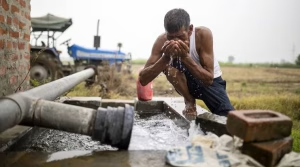GS1 – Geography

Context
India faces an intensifying water crisis triggered by over-extraction, climate change, and governance failures, demanding urgent and coordinated action for sustainability and resilience.
Current Water Stress in India
- Global Ranking: 13th among the most water-stressed countries (World Resources Institute).
- 600 million Indians face high to extreme water stress.
- 2030 Outlook:
- Demand may double supply (NITI Aayog).
- 21 cities, including Chennai, risk complete groundwater depletion.
- Contamination:
- 70% of water is contaminated.
- Over 2 lakh deaths annually from waterborne diseases.
Root Causes of the Crisis
- Over-Extraction & Mismanagement:
- Excessive groundwater use, especially for water-intensive crops like paddy.
- Unregulated urban expansion and shrinking water bodies.
- Pollution:
- Discharge of industrial waste and untreated sewage into rivers and lakes.
- Encroachment on wetlands.
- Climate Change:
- Erratic rainfall, floods, prolonged droughts disrupt water supply and agriculture.
- Poor Infrastructure:
- Old pipelines, leakages, and fragmented governance frameworks.
- Lack of Public Awareness:
- Water seen as a free and infinite resource discourages conservation.
Implications of Water Scarcity
- Economic:
- GDP may fall by 6% by 2050 (World Bank).
- Farmer income could fall by 15–25% in unirrigated areas.
- Social:
- Unsafe water affects child health, leading to malnutrition and disease.
- Ecological:
- Biodiversity loss and degradation of fragile ecosystems.
- Federal Tensions:
- Interstate water disputes (e.g., Cauvery river conflict).
- Geopolitical Risks:
- Cross-border issues with China (e.g., Brahmaputra damming).
Government Initiatives
| Scheme/Policy | Focus Area |
| Jal Shakti Abhiyan | Rainwater harvesting & recharge across 740 districts |
| Atal Bhujal Yojana | Community-based groundwater management in 7 high-stress states |
| Amrit Sarovar | Creation of 50,000 water bodies |
| Nal Se Jal | Piped water to all rural households by 2024 |
| Namami Gange | Cleaning and rejuvenation of Ganga River |
| National Water Policy | Advocates rainwater harvesting |
| Aquifer Mapping | Underground water mapping for sustainable use |
Way Forward
- Community-led Solutions:
- Revive traditional systems like Ahar-Pyne.
- Support programmes like Swajal.
- Nature-Based Approaches:
- Restore wetlands, floodplains, and forests.
- Technological Interventions:
- Use real-time water dashboards and AI-based tracking (e.g., Andhra Pradesh model).
- Policy Reforms:
- Mandatory rainwater harvesting, greywater reuse, and desalination in coastal areas.
- Institutional Reform (Mihir Shah Committee):
- Establish a National Water Commission by merging water bodies.
- Focus on dam maintenance and integrated governance.
- Public Participation:
- Engage local communities in planning and water governance.




